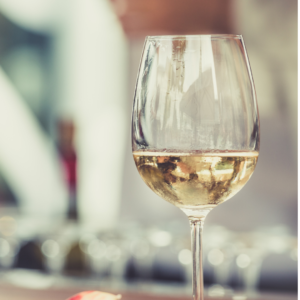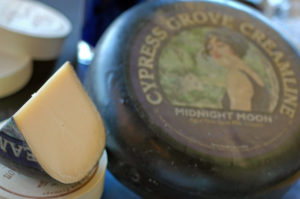
In the News
"Whether Annapolis is your home, your destination or a pit stop on the way to your beach vacation, Tastings Gourmet Market is the place to pick up a few provisions for an al fresco meal on the waterfront.”
The Washington Post
When what you’re drinking melds with what you’re eating, something magical takes place in your mouth, in terms of a sheer sensory experience.

I saw the light when I was sitting at the table with friends finishing a fabulous seven-course Italian spread. Sylvia, our hostess, placed a small, etched glass of Vin Santo before me accompanied by a piece of biscotti and a small wedge of Gorgonzola. I wasn’t particularly keen on sweet wines or blue cheese, for that matter, but I thought when in Rome do as the Romans do.
The flavors danced together, with one spiraling into the other, it tasted so good it hurt. Cheese and wine have been consumed together for thousands of years and yet, for the first time, I was experiencing this perfect marriage of flavors.
Since that epiphany moment, I’ve tasted a lot of wines and a lot of cheeses trying to re-create that divine experience.
Some were marriages made in heaven and some, unfortunately, were dreadful. Some cheeses had only one perfect wine partner while some wines had many possible cheese partners. To forge a successful relationship, here are three key principles to help you get closer to finding suitable companions.
A cheese’s texture is the most important characteristic when looking for a compatible wine partner because the texture of a cheese gives you a clear idea of its flavor. Is the cheese velvety and creamy or firm and dry?
By matching the texture in a wine you can rule out some obvious clashes. For example, a triple crème brie like Brillat-Savarin, with its fluffy, whipped-cream texture, pairs well with a light Champagne or other sparkling wine. The bubbles also provide a nice palate-cleansing contrast to the creaminess of the cheese.
On the other hand, a dense, lip-smacking cheese like a Vintage Gouda requires backbone in a partner. A thin, light wine would be crushed by the complexity of this aged cheese. Rather, choose a full-bodied “heavy” wine like Zinfandel or Syrah that has some age to it as well.
A “meaty” cheese, such as a wash-rind Morbier, is full, plump, flavorful and creamy. You can instantly recognize it by the line of ash running through the middle of the cheese. Choose a soft, round red wine such as a French Pinot Noir or Côtes du Rhône and experience bliss.
When it comes to harmony in the cheese-wine relationship either component should taste as good, if not better, with the pairing as it does on its own. Trust me you’ll know instantly when you have a bad marriage; the wine can become bitter and the cheese can become sour.
A simple guideline is to pair light wines with light cheeses and heavy wines with heavy cheeses. A light cheese is typically classified as a fresh or semi-soft cheese and is aged less than a month. Younger cheeses lack the complexity that older cheeses have acquired over time and would be better suited with a younger wine.

Young wines are usually defined as crisp, higher in acidity, lower in alcohol (10%-12%) and exposed to very little oak. The higher the acidity, the more crispness you will taste in a wine, making this pairing ideal. The amount of alcohol in a wine gives you an indication of the body of the wine. The higher the alcohol percentage, the more body and less likely it will go with lighter cheeses. Younger wines are not typically aged in oak barrels for very long so they lack that heavy, buttery, toasty notes of aged wines.
An example of a good pairing based on intensity is chèvre, or fresh goat cheese, with Sauvignon Blanc or Mozzarella with a light Sangiovese. Likewise, Pecorino Vecchio, aged 16 months is packed with mouthwatering flavor and should be paired with a vintage Brunello di Montalcino.
The only exception to this rule is pairing a big red wine with a bold blue cheese. One sip and you will know that this was a bad idea.
Fruitiness in wines, either red or white, makes it easier to pair with most cheeses. For the cheese-wine relationship to stand a chance stay away from bone-dry, tannic or over-oaked wines. These finicky partners can wreak havoc on your experience. Either the cheese or the wine will suffer. The salty and lactic flavors of the cheese can ruin a dry wine but can provide the right balance to a fruity wine.

Cypress Grove’s Midnight Moon, a semi-hard, aged goat’s milk cheese, walks the line between earthiness and fruitiness. The wine for this cheese should do the same. On the white side, a Gewürztraminer pairs very well because it has similar characteristics. On the red side, a Pinot Noir or medium-bodied Merlot shines.
What’s important in all of this is to keep it simple. You’ll know you have a perfect pairing when you can’t find where the wine ends and where the cheese begins. To bring these two ethereal pleasures together only requires you to have fun and be open to experimenting.
Did you know: Legend has it that after Romeo first met Juliet, a servant offered him some sweet wine. He replied, “Soave.” It is unknown whether he was referring to the wine or to his beloved Juliet. Soave comes from the Veneto region of Italy and pairs well with Gorgonzola, Taleggio and Pecorino Toscano.
Get immediate email notifications of new recipes. Enter your email below to sign up.
In the News
"Whether Annapolis is your home, your destination or a pit stop on the way to your beach vacation, Tastings Gourmet Market is the place to pick up a few provisions for an al fresco meal on the waterfront.”
The Washington Post